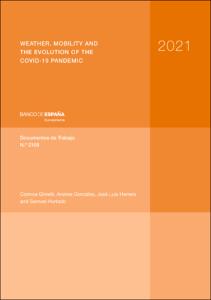Weather, mobility and the evolution of the Covid-19 pandemic
Autor
Fecha de publicación
10-mar-2021
Descripción física
32 p.
Resumen
Estimamos el coeficiente de reproducción efectivo (Rt) de la pandemia de Covid-19, con datos de casos detectados en Estados Unidos, a nivel de condado, entre febrero y septiembre de 2020. Con esta información estimamos el efecto de la climatología y de la movilidad sobre el ritmo de expansión de la pandemia. Encontramos un efecto fuerte y significativo de la meteorología: menores temperaturas están asociadas con mayores ritmos de expansión, y este efecto es mayor por debajo de 0ºC. Además, cuando las temperaturas son bajas, las precipitaciones están asociadas con un mayor Rt. En cuanto a la movilidad, encontramos que, en los casos de locales de comercio y recreo, estaciones de tránsito y lugares de trabajo, las reducciones de movilidad son efectivas en términos de frenar el ritmo de expansión de la pandemia, mientras que en el caso de los parques es un aumento de las visitas lo que ayuda a reducir el Rt. El efecto negativo de los aumentos de la movilidad general es mayor en condados con alta densidad de población, peores resultados en las pruebas PIAAC sobre comprensión lectora y de cálculo numérico, o una menor proporción de empleo en el sector servicios. Cuantitativamente, nuestras estimaciones implican que una reducción de 20ºC en las temperaturas entre verano e invierno aumentaría el Rt en +0,35, que puede ser la diferencia entre una evolución bien controlada y un comportamiento explosivo; y si esto no se consigue neutralizar mediante mejoras generales en la estrategia de lucha contra la pandemia, la reducción adicional en la movilidad que sería necesaria para compensar ese efecto es equivalente a retornar, desde los niveles más relajados apreciados en verano, a los niveles más estrictos de reducción de la movilidad observados en Estados Unidos en abril.
We estimate the effective reproduction number (Rt) of the current Covid-19 pandemic, with US daily infections data between February and September of 2020, at the county level. This is then used to estimate the effect of weather and mobility on the spread of the pandemic. We find a strong and significant effect of the weather: lower temperaturas are associated with a higher Rt, and this effect is bigger at temperatures below 0ºC. At low temperatures, precipitations are also associated with a higher Rt. We also find that mobility reductions related to certain types of locations (retail and recreation, transit stations, and workplaces) are effective at reducing Rt, but it is an increase of the time spent in parks that helps reduce the spread of the pandemic. The negative effect of increased general mobility is bigger in counties with higher population density, worse numeracy and literacy PIAAC scores, or a lower share of employment in the services sector. Quantitatively, our estimates imply that a 20ºC fall in temperatures from summer to winter would increase Rt by +0.35, which can be the difference between a wellcontrolled evolution and explosive behavior; and, if this can’t be neutralized through general improvements in the fight to stop the pandemic, the additional reduction in mobility that would be needed to compensate for this would be equivalent to returning, from the more relaxed levels observed in the summer, back to the strictest mobility reductions recorded in the US in April.
We estimate the effective reproduction number (Rt) of the current Covid-19 pandemic, with US daily infections data between February and September of 2020, at the county level. This is then used to estimate the effect of weather and mobility on the spread of the pandemic. We find a strong and significant effect of the weather: lower temperaturas are associated with a higher Rt, and this effect is bigger at temperatures below 0ºC. At low temperatures, precipitations are also associated with a higher Rt. We also find that mobility reductions related to certain types of locations (retail and recreation, transit stations, and workplaces) are effective at reducing Rt, but it is an increase of the time spent in parks that helps reduce the spread of the pandemic. The negative effect of increased general mobility is bigger in counties with higher population density, worse numeracy and literacy PIAAC scores, or a lower share of employment in the services sector. Quantitatively, our estimates imply that a 20ºC fall in temperatures from summer to winter would increase Rt by +0.35, which can be the difference between a wellcontrolled evolution and explosive behavior; and, if this can’t be neutralized through general improvements in the fight to stop the pandemic, the additional reduction in mobility that would be needed to compensate for this would be equivalent to returning, from the more relaxed levels observed in the summer, back to the strictest mobility reductions recorded in the US in April.
Publicado en
Documentos de Trabajo / Banco de España, 2109
Materias
Pandemia; Covid-19; Coronavirus; Temperatura; Climatología; Meteorología; Movilidad; Restricciones; Datos de panel; Pandemic; Covid-19; Coronavirus; Temperature; Weather; Mobility; Panel data; Recursos naturales y medio ambiente; Seguridad social y programas de asistencia social; Economía regional y recursos naturales; Modelos econométricos; Estados Unidos
Aparece en las colecciones:












